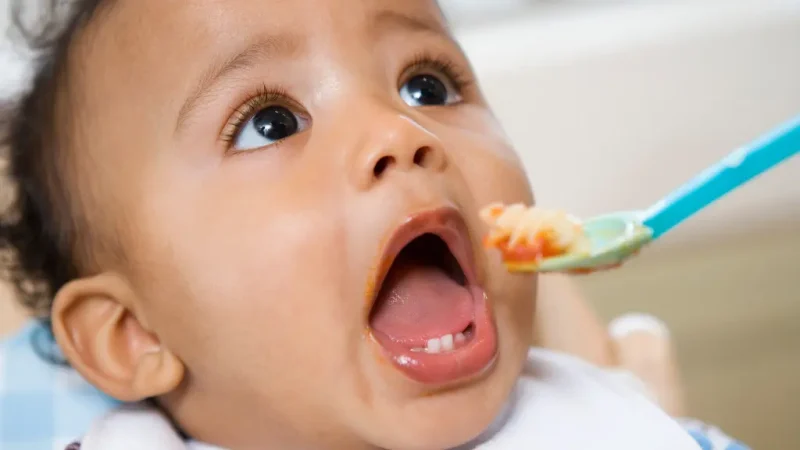What causes heavy metal toxicity in toddlers? This question has been worrying parents and health professionals alike.
Heavy metal toxicity is a serious concern, especially for our littlest ones, who are more vulnerable to its effects.
The main culprits behind this issue are a higher food intake to body weight ratio, greater intestinal absorption, and lower excretion in toddlers than adults. These factors make them more susceptible to accumulating harmful heavy metals in their bodies.

In this article, we’ll explore the causes, symptoms, and prevention of heavy metal toxicity in toddlers, providing you with the knowledge to keep your little ones safe and healthy.
What’s the Big Deal with Heavy Metals?
First, let’s break down what we mean by “heavy metals.” These aren’t the cool guitar riffs you hear on the radio.
In science and health, heavy metals refer to elements like lead, mercury, arsenic, and cadmium. While some of these metals are naturally occurring and even necessary for our bodies in tiny amounts, too much can be harmful – especially for our little ones.
Why Toddlers Are More Vulnerable
Now, you might wonder, “Why are toddlers more at risk than adults?” Great question! The answer lies in three key factors:
- Higher food intake to body weight ratio: Toddlers eat more food in proportion to their body size compared to adults. It’s like if you ate a whole pizza for every meal – that’s a lot of potential exposure!
- More excellent intestinal absorption: Little bodies are like super-efficient sponges, absorbing more of what they consume, including any nasty heavy metals lurking in their food or environment.
- Lower excretion: Toddlers’ bodies aren’t as good at getting rid of toxins as adult bodies are. It’s like having a less efficient filtering system.
The Sneaky Sources of Heavy Metals
Heavy metals are like ninjas—they can sneak into our toddlers’ lives unexpectedly. Let’s unmask these sneaky culprits!
1. The Food Factor
You’d be surprised where heavy metals can hide in your toddler’s diet. Some common sources include:
- Rice and rice-based products: These can sometimes contain arsenic.
- Fish: Certain types of fish may contain mercury.
- Fruit juices: Some juices have been found to contain lead or arsenic.
2. The Water Woes
Water, the source of life, can sometimes contain heavy metals. Old pipes or contaminated water sources can introduce lead and other metals into your toddler’s drinking water.
3. The Dusty Danger
Dust isn’t just annoying to clean—it can also be a health hazard. Household dust can contain lead from old paint, especially in older homes.
4. The Toy Story
Some toys, especially older or imported ones, might contain heavy metals in their paint or materials. It’s like a not-so-fun game of hide and seek!
Signs and Symptoms: When to Worry
I know what you’re thinking: “How do I know if my toddler has been exposed to heavy metals?” Well, it’s not always easy to tell, but here are some signs to watch out for:
General Symptoms
- Fatigue or weakness
- Irritability
- Loss of appetite
- Weight loss
- Constipation
Cognitive and Behavioral Signs
- Difficulty concentrating
- Learning problems
- Hyperactivity
- Aggressive behavior
Physical Symptoms
- Headaches
- Abdominal pain
- Vomiting
- Muscle weakness
Remember, many different things can cause these symptoms, so don’t panic if you notice them. Always consult with your pediatrician if you’re concerned.
The Long-Term Impact: Why We Need to Act Now
Heavy metal toxicity isn’t just a short-term problem. It can have lasting effects on our little ones’ health and development.
Let’s take a closer look at what’s at stake:
1. Brain Development
Heavy metals like lead and mercury can interfere with brain development. It’s like trying to build a house with faulty materials – the foundation isn’t as strong.
2. Growth and Physical Development
Exposure to heavy metals can slow down growth and affect physical development. Imagine trying to grow a plant in soil that’s not quite right – it might not reach its full potential.
3. Behavioral Issues
Some heavy metals have been linked to behavioral problems and learning difficulties. It’s as if these metals are creating static in the brain’s communication system.
4. Organ Damage
In severe cases, heavy metal toxicity can damage vital organs like the kidneys and liver. These organs are like the body’s cleaning crew, and heavy metals can overwhelm them.
Prevention: Your Toddler’s Shield Against Heavy Metals
Now that we know the risks, let’s discuss how to protect our little ones. Think of these tips as your toddler’s personal superhero shield against heavy metals!
1. Diet Defenses
- Variety is key: Mix up your toddler’s diet to avoid overexposure to any one potential source of heavy metals.
- Wash fruits and vegetables: Give them a good rinse to remove any surface contaminants.
- Choose fish wisely: Opt for low-mercury fish options like salmon or tilapia.
2. Water Wisdom
- Test your water: If you’re on well water or live in an older home, consider having your water tested for heavy metals.
- Use a water filter: A good quality filter can help remove many contaminants.
3. Home Health Check
- Keep it clean: Regular dusting and vacuuming can reduce exposure to lead-contaminated dust.
- Check for lead paint: If your home was built before 1978, have it checked for lead-based paint.
4. Toy Tactics
- Choose wisely: Opt for toys from reputable manufacturers that follow safety standards.
- Avoid old or recalled toys: These might contain heavy metals in their paint or materials.
Testing and Treatment: What to Do If You’re Worried
If you’re concerned about heavy metal exposure in your toddler, don’t panic! There are steps you can take to address the issue.
1. Talk to Your Pediatrician
Your child’s doctor is your best resource. They can advise on whether testing is necessary and guide you through the process.
2. Blood Tests
A simple blood test can detect the presence of many heavy metals in your toddler’s system. It’s like a spy mission to uncover any hidden intruders!
3. Environmental Testing
If heavy metals are detected, your doctor might recommend testing your home environment to find the source.
4. Treatment Options
Treatment depends on the type and level of exposure. It might include:
- Removing the source of exposure
- Nutritional support
- In severe cases, chelation therapy (a treatment that helps remove heavy metals from the body)
The Role of Nutrition in Fighting Heavy Metal Toxicity
Did you know a healthy diet can be your toddler’s secret weapon against heavy metal toxicity? It’s true! Let’s explore how good nutrition can help:
1. Iron-Rich Foods
Iron can help prevent the absorption of heavy metals like lead. Think of it as a bouncer at the door of your toddler’s body, keeping the bad guys out. Good sources include:
- Lean meats
- Beans
- Fortified cereals
2. Calcium Champions
Calcium competes with lead for absorption in the body. It’s like a superhero swooping in to save the day! Include these calcium-rich foods in your toddler’s diet:
- Milk and dairy products
- Leafy green vegetables
- Calcium-fortified foods
3. Vitamin C Crusaders
Vitamin C helps the body absorb iron better and can also help eliminate some heavy metals. It’s like a cleanup crew for your toddler’s system. Good sources include:
- Citrus fruits
- Berries
- Bell peppers
4. Fiber Fighters
Fiber can help bind to heavy metals in the digestive system and carry them out of the body. Think of it as a broom sweeping away the bad stuff. Fiber-rich foods include:
- Whole grains
- Fruits and vegetables
- Legumes
The Global Perspective: Heavy Metal Toxicity Around the World
Heavy metal toxicity in toddlers isn’t just a problem in one country or region – it’s a global issue. Let’s take a quick trip worldwide to see how different areas are affected and what’s being done about it.
1. Developing Countries
In many developing countries, heavy metal exposure is a significant problem due to:
- Lack of regulations on industrial pollution
- Use of leaded gasoline in some areas
- Limited access to clean water
2. Industrialized Nations
Even in more developed countries, heavy metal toxicity remains a concern:
- Old infrastructure (like lead pipes) can introduce metals into water supplies
- Industrial sites and e-waste recycling can create localized hotspots of contamination
3. Global Efforts
The good news is that there are global efforts to combat heavy metal toxicity:
- The World Health Organization (WHO) has guidelines for safe levels of heavy metals in food and water.
- Many countries have banned leaded gasoline and lead-based paints
- International agreements aim to reduce mercury pollution
The Future: Hope on the Horizon
While heavy metal toxicity in toddlers is a serious issue, there’s reason to be optimistic about the future. Let’s look at some promising developments:
1. Advancing Science
Researchers are constantly developing new ways to detect and treat heavy metal toxicity. We’re getting better binoculars to spot the problem and better tools to fix it.
2. Stricter Regulations
Many countries are implementing stricter regulations on heavy metals in consumer products, food, and the environment. It’s like putting up better fences to keep the bad stuff out.
3. Increased Awareness
As more people become aware of the issue, there’s greater pressure on industries and governments to take action. Knowledge is power; in this case, it’s the power to protect our little ones.
4. Innovative Solutions
Innovative solutions are being developed to reduce heavy metal exposure, from new water filtration technologies to safer manufacturing processes. We’re creating a cleaner, safer world for our toddlers, one step at a time.
Conclusion: Empowering Parents in the Fight Against Heavy Metal Toxicity
We’ve covered a lot of ground in our exploration of heavy metal toxicity in toddlers. From understanding why our little ones are more vulnerable to identifying sources of exposure, recognizing symptoms, and learning prevention strategies, we’ve armed ourselves with knowledge to protect our children.
Remember, while heavy metal toxicity is a serious issue, it’s not an insurmountable one. By staying informed, taking preventive measures, and working with healthcare professionals when needed, we can significantly reduce the risk to our toddlers.
Parents and caregivers are the frontline defenders in keeping our children safe and healthy. It might seem daunting at times, but remember – every small step you take, from choosing the right foods to keeping your home clean, makes a big difference in your toddler’s health and future.
So, let’s raise our sippy cups (filled with filtered water, of course) to create a safer, healthier world for our little ones. After all, they’re our most precious metal and deserve nothing but the best!
